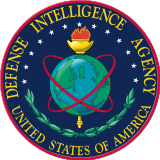National Center for Medical Intelligence
The National Center for Medical Intelligence (NCMI; formerly known as the Armed Forces Medical Intelligence Center) is a component of the Defense Intelligence Agency (DIA).[1] Headquartered at Fort Detrick, Maryland, NCMI's mission is to monitor, track and assess a full range of global health events that could negatively impact the health of U.S. military and civilian populations.[2]
History
The NCMI traces its origins to the organization of a medical intelligence section in the Office the Surgeon General of the United States Army during World War II. Prior to entry into the war, the Surgeon General established medical intelligence to support planning for the administration of military governments in U.S. Army occupied territories occupied by providing detailed guides for civil public health and sanitation conditions. As the prospect of United States entry into the war increased, the need for a full-time staff of medical intelligence analysts became apparent. During the war, medical intelligence products were part of formal war planning with the incorporation of health and sanitary data into War Department Strategic Surveys.
In 1963, the DIA absorbed medical intelligence as a division in its production branch. During the later Cold War era, the medical intelligence division underwent several evolutions in size, structure and specific function. In the early 1970s, the division became victim of DoD downsizing initiatives in the post-Vietnam era. Recognizing its importance, the Army Surgeon General again took sole responsibility for the medical intelligence function in the form of the United States Army Medical Intelligence and Information Agency (USAMIIA). USAMIIA transferred to Fort Detrick in 1979 and was renamed as AFMIC in 1982 when it became a tri-service organization.[3] Congress mandated the permanent transfer of AFMIC to DIA in 1992 under the DoD Authorization Act.[4] As of January 1992, AFMIC became a DIA field production activity.
On July 2, 2008, AFMIC was formally redesignated as the NCMI in a ceremony at Ft. Detrick.[5] In 2010, the center received a facility expansion that added workspaces, conference and training rooms, and additional parking.[6]
Organization
The NCMI is organized into a support division and two substantive divisions—the Epidemiology and Environmental Health Division and the Medical Capabilities Division. Each substantive division is made up of two teams, the duties of which include:
Environmental Health
- Identify and assess environmental risks that can degrade force health or effectiveness including chemical and microbial contamination of the environment, toxic industrial, chemical and radiation accidents, and environmental terrorism/warfare.
- Assess the impact of foreign environmental health issues and trends on environmental security and national policy.
Epidemiology
- Identify, assess, and report on infectious disease risks that can degrade mission effectiveness of deployed forces and/or cause long-term health implications.
- Alert operational and policy customers to foreign disease outbreaks that have implications for national security and policy formulation, including homeland defense and deliberately introduced versus naturally occurring disease outbreaks.
Life Sciences and Biotechnology
- Assess foreign basic and applied biomedical and biotechnological developments of military medical importance.
- Assess foreign civilian and military pharmaceutical industry capabilities.
- Assess foreign scientific and technological medical advances for defense against nuclear, biological and chemical warfare.
- Prevent technological surprise.
- Prevent proliferation of dual-use equipment and knowledge.
Medical Capabilities
- Assess foreign military and civilian medical capabilities, including treatment facilities, medical personnel, emergency and disaster response, logistics, and medical/pharmaceutical industries.
- Maintain and update an integrated data base on all medical treatment, training, pharmaceutical, and research and production facilities.
Mission
NCMI's mission, always critical to protecting the health of deployed forces, has grown even more important recently with support to Operations Enduring Freedom and Iraqi Freedom and the global war on terrorism.[7] At the same time, the center is increasing its use of new technologies to transform its delivery of timely, forward-leaning, customer-focused medical intelligence.
As part of the DIA, this tri-service organization produces finished, all-source medical intelligence assessments, forecasts and databases on foreign military and civilian health care capabilities and trends, worldwide infectious disease risks, global environmental health risks, and militarily significant life science issues, to include biotechnology and nuclear, biological and chemical medical defense advancements.
NCMI is the only organization in the world with this comprehensive medical intelligence mission. As such, it has a diverse customer base, from operational and tactical commanders, preventive medicine personnel, and medical planners and researchers to the policymakers in the DoD, the White House staff and other federal agencies.
Until 2013, the director was United States Air Force Colonel Anthony Rizzo.
See also
References
- ↑ DoD Instruction 6420.01, "National Center for Medical Intelligence (NCMI)", March 20, 2009, http://ftp.fas.org/irp/doddir/dod/i6420_01.pdf.
- ↑ Matthew Watson: "DIA Establishes National Center for Medical Intelligence", http://www.upmc-biosecurity.org/website/biosecurity_briefing/archive/govt_response/2008-07-11-dianatlctrmedintell.html, July 11, 2008.
- ↑ Robert L. Bolin: Army Technical Intelligence Chronology, Chapter 4: Official Documents, University of Nebraska-Lincoln, Lincoln, Neb., 2000, online at http://unllib.unl.edu/Bolin_resources/TI/tech-int.html, Version 7.05; Revised, March 22, 2005.
- ↑ Jeffrey T. Richelson: The U.S. Intelligence Community, Boulder, Colo.: Westview Press, 1999, p. 62.
- ↑ Colonel Anthony M. Rizzo, Director, National Center for Medical Intelligence: "Meeting Emerging and Constantly Changing Health Threats with a Central Point of Information and Intelligence", Military Medical/CBRN Technology, 2008 Volume: 12 Issue: 5 (August), http://www.military-medical-technology.com/mmt-archives/24-mmt-2008-volume-12-issue-5/146-national-center-for-medical-intelligence.html.
- ↑ Megan Eckstein, News-Post Staff: "Medical Intelligence group adds much-needed office space at Fort Detrick", Frederick News-Post, http://www.fredericknewspost.com/archive/article_d81fa175-2de5-5109-830e-b71a5a534900.html?mode=jqm, Posted Nov 10, 2010.
- ↑ Megan Eckstein: "Detrick soldiers steadily being sent to Middle East", Frederick News-Post, originally published January 17, 2010, http://www.fredericknewspost.com/sections/news/display.htm?storyid=100201.
